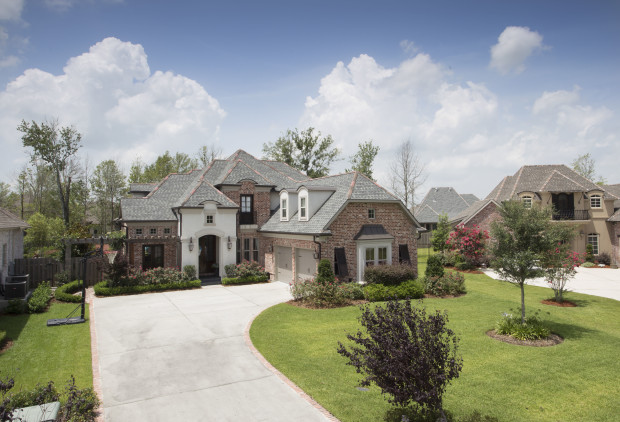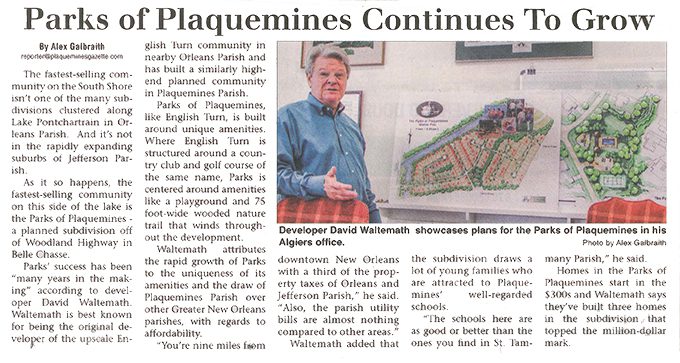Options Are Key to the Evolving Home Market
As the home market evolves, lot “options” become key.
Though swamps and bayous are among the signature features of life in southern Louisiana, for a growing base of home-buyers, water may mean they feel they have fewer options. Complicating matters further, Realtor Magazine now estimates that the two big markets in the coming years couldn’t be more different—millennials looking for their first or second home, and baby boomers looking for a retirement-era change.
“For the business I’m doing, there’s not a lot of supply,” David Waltemath, the developer behind Parks of Plaquemines in Belle Chasse said. “That supply is really, really restricted by wetlands.”
Finding good home options comes down to what those like Waltemath, a second-generation developer, do with limited land options. Many create simple subdivisions — laying down streets, divvying up lots — but plan for little else.
Developers such as Waltemath, however, say the key to this new real estate market is to not just create homes, but create communities.
In the Parks of Plaquemines community, for example, Phase 3 offers three different lot sizes, which range from compact “villa” or “garden” lots (at approximately 60 by 140 feet), to expansive “estate” lots (at approximately 150 by 250 feet). Waltemath is careful to note, however, that size does not imply value or cost, but rather a lifestyle choice. The type of home on these lots varies according to taste.
“So we’ll have a villa in one of our neighborhoods that might be $700,000, but we might also have a villa that might be $375,000,” Waltemath said. “It’s about lifestyle — one might be an empty-nester, and one might be a young family.” He added that the Parks’ structured Architectural Review Committee protects the integrity and cohesiveness of the community and strengthens the owners’ individual investments, while allowing maximum design flexibility.
The result is an often unavailable matrix of options for home buyers. The range of options for baby boomers, in particular, comes at a time when the face of retirement is changing. The National Association of Home Builders  notes that people are retiring later and staying active for longer. Planning for “aging-in-place” often includes a wide array of considerations, such as walkability, “flex space” for a home office and easy-to-maintain exteriors. Meanwhile, a survey of millennials from Realtor.com finds that, while the under-36 crowd will lead the way in home-buying this year, nearly 30 percent of these recession-era adults will base their decision on finding a home easily within their budget.
notes that people are retiring later and staying active for longer. Planning for “aging-in-place” often includes a wide array of considerations, such as walkability, “flex space” for a home office and easy-to-maintain exteriors. Meanwhile, a survey of millennials from Realtor.com finds that, while the under-36 crowd will lead the way in home-buying this year, nearly 30 percent of these recession-era adults will base their decision on finding a home easily within their budget.
Providing options not only attracts a wide range of buyers, but also helps create “neighborhoods.” Waltemath said that The Parks of Plaquemines — unlike typical subdivisions that cater to a narrow demographic and offer a single lot size — offers buyers for Phase 3 a community that is much more than just a bedroom. Retirees can come to know newlyweds, or young professionals looking to start a family can intermingle with budding families.
“(Those options) give us the ability to have prices that range from the upper 300’s to over a million,” Waltemath said. “You have the opportunity to have multiple generations of one family (in the same community).”
Another mistake Waltemath sees developers make is in how much they allocate for green spaces, such as parks, trails and playgrounds. The rush to get as many homes per square acre from an investment often leaves unsuspecting buyers encased by surrounding lawns and fences. Buyers looking for a home in a development should be careful to consider green space, especially in the early days before every home is built. Trails and common spaces add immeasurable value, ensuring that even those buyers who opt for small lots can enjoy numerous outdoor activities—from family walks to fishing trips—without getting in the car.
“(At The Parks), one might say ‘There’s a lot of parks and trails, I don’t need a great big home site, I’ll build on a (villa-sized lot),” Waltemath said. “(Green space) gives a lot of options, unlike a subdivision where every lot is maybe 90 by 140 (feet).”
Waltemath said the old adage for a good home — location, location, location — shouldn’t be neglected, either. As developers scramble to find space for new homes, it’s still important for buyers to consider where their home sits in relation to the rest of their life. Waltemath considers himself “lucky” to have acquired the hundreds of acres that comprise The Parks of Plaquemines. The location, he said, is only a short drive from the city and has a top-rated school district. Coupled with low taxes and a virtually flood-free area, developments such as The Parks quickly become an attractive option for virtually any lifestyle or budget.
“The thing that makes The Parks special is the pool and the amenity package,” Waltemath notes of his development. “But also (there’s) the benefits that come out of Plaquemines Parish.”
Whether it’s a big home on a small lot, or a big lot with a little home, options are the key. Buyers should increasingly look for developments that understand the value of cultivating a whole community. And that means green space, variably-sized lots and shared amenities.


